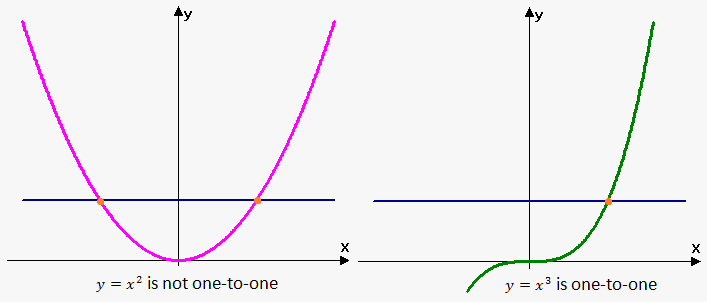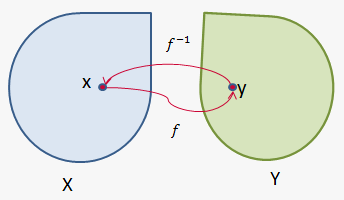Inverse of a Function
We already know that a function is a rule that allows finding for every value of the corresponding value of . But what if we are given a rule, i.e. a function, and the value of and we want to find the corresponding value of ?
In other words, we want to find a function that will express in terms of . Such a function is called an inverse function and is denoted by .
If , the inverse function is .
For example, if , it can be stated that , because .
Not all functions have a unique inverse. Let's take the function . Since and , it can be concluded that is undefined, because there are 2 values that correspond to , namely and . Therefore, the inverse of is a multi-valued function. In this case, we will say that the function doesn't have an inverse, because the inverse is a multi-valued function, which we don't consider to be a function.
So, a function will have an inverse only when for different values of we have different values of .
Definition: a function is called one-to-one (or injective), if it never takes the same value twice, i.e. whenever .

One-to-one functions are precisely the functions that possess inverse functions.
From this definition, it follows that is not a one-to-one function, because ; so, different values have the same output.
On the other hand, is a one-to-one function, because whenever (different values can't have the same cube). Thus, has an inverse.
Graphically, we can determine whether a function is one-to-one using the horizontal line test.
Horizontal line test. A function is one-to-one if and only if no horizontal line intersects its graph more than once.

Now, let's give a more formal definition of the inverse function.
Definition. Let be a one-to-one function with the domain and the range . Then, its inverse function has the domain and the range and is defined as follows: .
Note that the domain of equals the range of and the range of equals the domain of .
When we want to concentrate on the inverse function, we will usually write , i.e. we will interchange and , because we traditionally use as an independent variable.
The inverse function means that if we apply to , we will obtain .

If we now apply to , we will arrive back at . And vice versa: applying to and then applying to the result will bring us back to .
As a result, we can say that a function and its inverse cancel the influence of each other.
Thus, there are two properties of inverse functions:
- for any from .
- for any from .
Example 1. Given , , , find , , .
, because .
, because .
is undefined, because we are not given the value of for which .
Now, let’s see how to compute inverse functions. Since we have , we need to express in terms of to obtain .
Steps for finding an inverse:
- Write .
- Express in terms of (if possible). You will get .
- To obtain , interchange and .
Actually, we can first perform step 3 and then step 2, i.e. interchange and , and then express in terms of .
Example 2. Find the inverse of .
- .
- .
- is the inverse.
Let's work another short example.
Example 3. Find the inverse of .
- .
- , or .
- is the inverse.
To verify whether we found the inverse correctly, check if holds.
Here, , and ; so, .
Thus, we found the inverse correctly.
Interchanging the roles of and gives the opportunity to plot the graph of the inverse function based on the graph of the function . Since the point lies on the graph of , we have that lies on the graph of . So, the graph of the inverse is obtained by reflecting the graph of the function about the line .
Example 4. Sketch the graph of and its inverse.
The domain of is , or . The range is .

This means that the domain of the inverse is and the range is .
To find the equation of the inverse, we write in terms of : , or . Now, interchange and : .
So, the inverse is .
Now, we draw the graph of the function on the interval and then reflect it about the line .
